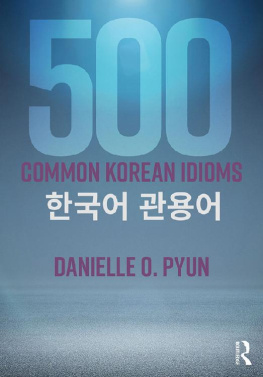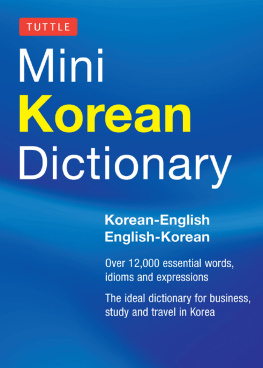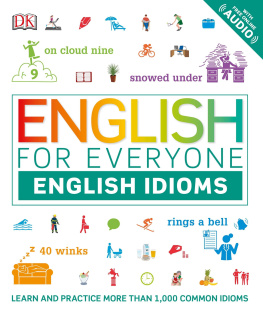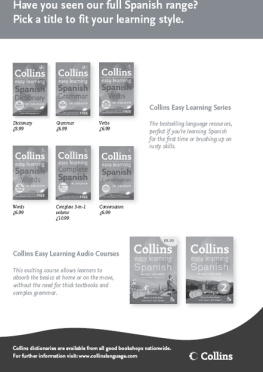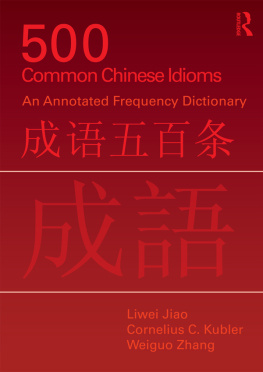500 Common Korean Idioms
500 Common Korean Idioms is a useful learners tool that presents the 500 most commonly used Korean idioms in a clear and easy-to-follow manner.
Structured with practicality in mind, the book presents:
- idioms with their literal and natural translations;
- usage notes describing the meaning, typical use, and any related cultural topic;
- several example sentences providing context and showing appropriate use of each idiom;
- important vocabulary and expressions highlighted in each chapter for review;
- an MP3 file for each idiom (online).
Suitable for intermediate to advanced learners of Korean, 500 Common Korean Idioms provides a step-by-step approach to gaining greater fluency through a grasp of the most common idioms in the language.
Danielle O. Pyun is Associate Professor of Korean at the Ohio State University, USA.
500 Common Korean Idioms
Danielle O. Pyun
First published 2018
by Routledge
2 Park Square, Milton Park, Abingdon, Oxon OX14 4RN
and by Routledge
711 Third Avenue, New York, NY 10017
Routledge is an imprint of the Taylor & Francis Group, an informa business
2018 Danielle O. Pyun
The right of Danielle O. Pyun to be identified as author of this work has been asserted by her in accordance with sections 77 and 78 of the Copyright, Designs and Patents Act 1988.
All rights reserved. No part of this book may be reprinted or reproduced or utilised in any form or by any electronic, mechanical, or other means, now known or hereafter invented, including photocopying and recording, or in any information storage or retrieval system, without permission in writing from the publishers.
Trademark notice: Product or corporate names may be trademarks or registered trademarks, and are used only for identification and explanation without intent to infringe.
British Library Cataloguing-in-Publication Data
A catalogue record for this book is available from the British Library.
Library of Congress Cataloging-in-Publication Data
Names: Pyun, Danielle Ooyoung, author.
Title: 500 common Korean idioms / Danielle O. Pyun.
Other titles: Five hundred common Korean idioms
Description: New York, NY: Routledge, 2018.
Identifiers: LCCN 2017039529 | ISBN 9781138698277 (hardcover: alk. paper) |
ISBN 9781138698284 (softcover: alk. paper) | ISBN 9781315519494 (ebook)
Subjects: LCSH: Korean languageIdioms. | Korean languageStyle. |
Korean languageRhetoric.
Classification: LCC PL927.6 .P98 2018 | DDC 495.73/13dc23
LC record available at https://lccn.loc.gov/2017039529
ISBN: 978-1-138-69827-7 (hbk)
ISBN: 978-1-138-69828-4 (pbk)
ISBN: 978-1-315-51949-4 (ebk)
Typeset in Times New Roman
by Apex CoVantage, LLC
Visit the eResources: www.routledge.com/9781138698277
Contents
Guide
I wish to express my sincere gratitude to Byung Joon (Bryan) Ahn, who reviewed the draft manuscript from a learners perspective, offered suggestions, and made edits. His work and input were invaluable and significantly improved the book. Any remaining errors or deficiencies in the book are solely my responsibility.
Like any other language, Korean is full of idioms both in speech and in text. Idioms can be a challenge for language learners, because their figurative meanings cannot easily be derived from their literal meanings. For example, the Korean expression literally means to eat noodles. This expression can be used literally, as in (I ate noodles for lunch). However, when it is used figuratively, it means to hold a wedding. For example, ? means When is the big day? Idioms are often linked to the cultural practices and traditions of those who use them. For example, traditionally in Korea, noodles were served at wedding banquets. The long noodles were a symbol of wishing the newlyweds a long and happy life together. By learning Korean idioms, you can gain insight into the culture and thoughts of Korean speakers, and improve your Korean proficiency overall.
This book explains 500 common Korean idioms. In this book, idioms are broadly defined as phrases or sentences that involve figurative meaning. They include fixed phrases, proverbs, slang, colloquialisms, and common metaphorical expressions. The book is designed for Korean language learners at or above the intermediate level who wish to expand the scope of their vocabulary and expressions as well as for those who want to enrich their ability to communicate effectively and naturally in Korean.
In this book, idioms are arranged in the order of the Korean alphabet. That is, they follow the dictionary sequence of Korean consonants and vowels.
The order of consonant letters: , , , , , , , , , , , , , , ,, , ,
The order of vowel letters: , , , , , , , , , , , , , , , , , ,
As shown in the following example, each entry is presented with its definition, an explanation of its meaning or usage, and two examples of its use.
| to make a fuss after the event; to hear the news too late; to be behind the beat |
| [lit.] to play the drum late |
When a person is slow in catching up with news or updates, he or she is said to (play the drum belatedly).
For example, if you talk or fuss about something that everybody knows or about something that happened a while ago, you will be told (You are playing the drum too late). The noun may also be used, in phrases such as (You are a belated drum). This expression is mostly used between close ones in a casual conversation and not toward ones seniors or elders. - : , ? .
Hey, did you know? Apparently Changsok and Suzy are dating.
: ? .
Youre so late! Everybody knows that.
: ? ?
Really? Im the only one that didnt know? - : , .
Hey, I heard that our economics class tomorrow was canceled.
: ..
I know. Youre a little late.
| - : news
- : to date, to go out
- ~(): They say ~, I hear ~
- : fact, truth
- : to not know
- : Is it that ~
- : economics
- : lecture, class
- : to be canceled
|
1. The idiom and its figurative and literal meaning
Each entry starts with a Korean idiom and is followed by its figurative meaning and literal meaning. Its literal meaning is indicated by [lit.].
2. Type of expression
When applicable and necessary, the type of idiom is indicated using brackets < >.
- : Informal indicates that the idiom is typically used in informal and casual settings. It is best to refrain from using such idioms in formal or professional settings.
- : Colloquial expressions are most frequently used in ordinary oral conversations, although sometimes found in formal speech or writing.
- : When using expressions marked as slang, it is best to take context and appropriateness into account. Acceptable use of slang is often restricted to people of equal or younger age, close acquaintances, and highly casual settings. Some slang expressions may be short-lived: they may be frequently used for a period of time but then quickly die out.
- : A proverb is a popular saying that typically presents the experience of the speaker or the wisdom or lesson gained from the experience. Since some proverbs have been handed down for many generations, they include archaic or obsolete words that are rarely used in modern Korean. The boundary between proverbs and idiomatic phrases can be vague or ambiguous. In labeling a phrase as a proverb, I referred to the Korean Standard Dictionary by the National Institute of Korean Language (http://stdweb2.korean.go.kr/main.jsp), which classifies proverbs and idiomatic phrases on separate pages.

